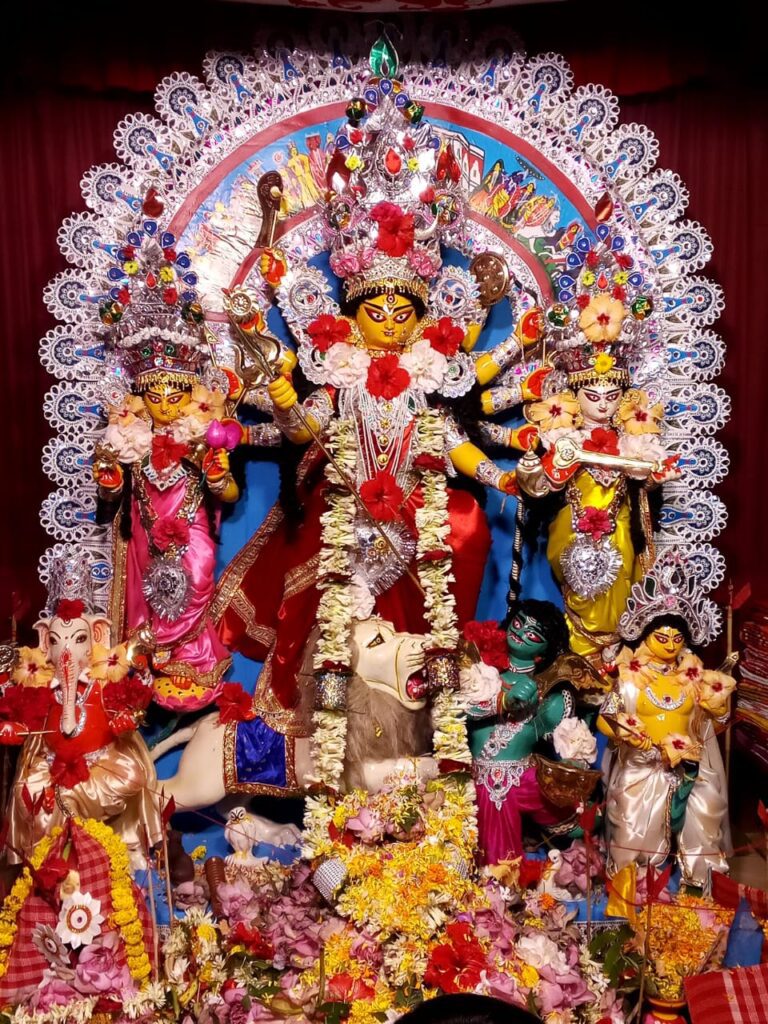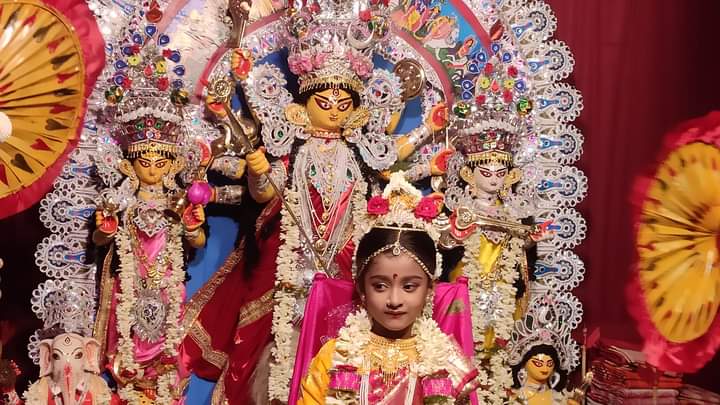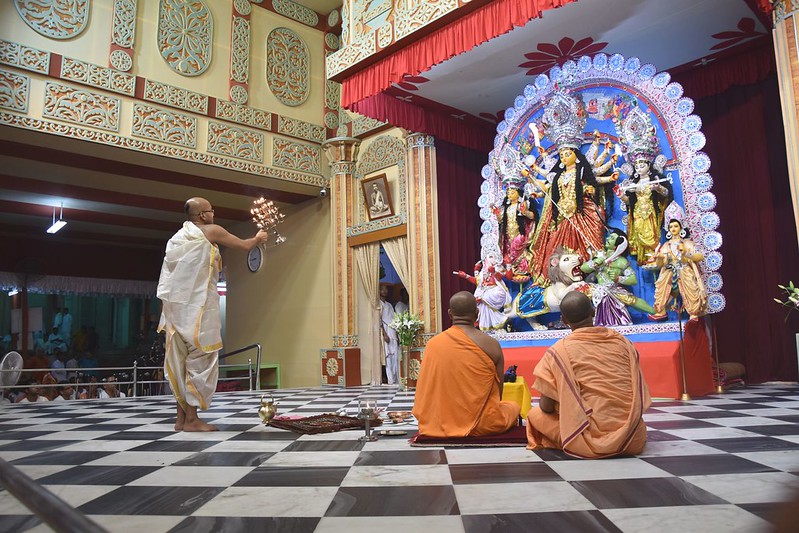It gives immense joy and happiness when you hear that Durga Puja is coming. I belong to a Bengali Brahmin family and Durga is a big festival especially for all Bengalis around the world.
Durga Puja, one of the most significant festivals in Hinduism, is a grand celebration of the victory of good over evil, symbolizing the triumph of Goddess Durga over the demon Mahishasura. This festival holds immense cultural, spiritual, and social importance, particularly in India, where it is celebrated with great enthusiasm. Durga Puja transcends religious boundaries and has evolved into a celebration of life, spirituality, and culture, bringing communities together in worship and festivity.
This article delves into the origins, religious significance, cultural impact, and deeper spiritual meanings of Durga Puja within Hinduism.

Origins and Mythological Significance
The legend of Durga Puja is deeply rooted in Hindu mythology, specifically in the “Devi Mahatmya” from the Markandeya Purana, which recounts the tale of the demon Mahishasura. Mahishasura, after receiving a boon that made him invincible to gods and humans, became a tyrant, causing chaos and destruction. Unable to defeat him, the gods combined their powers to create a divine female warrior—Goddess Durga.
Durga, embodying the collective strength and power of all the gods, fought a fierce battle with Mahishasura and ultimately slayed him, restoring peace and order to the cosmos. This event symbolizes the victory of righteousness (Dharma) over evil (Adharma), making Durga the epitome of strength, courage, and protection. Durga Puja commemorates this victory and celebrates her as the ultimate source of power and divine energy, known as “Shakti.”
Religious Significance of Durga Puja
Durga Puja is primarily celebrated in the Hindu month of Ashwin (September-October) over a span of nine days, known as Navaratri. The festival concludes with Vijayadashami, symbolizing Durga’s victory over Mahishasura. Each day of Durga Puja is dedicated to worshipping different forms of the goddess, emphasizing various aspects of her divine personality—compassionate mother, fierce protector, and source of wisdom.
In Hinduism, Durga is revered as the protective mother who defends her devotees from evil forces. Her fierce form represents the divine feminine power that annihilates all obstacles and restores balance in the universe. Through her worship, devotees seek her blessings for strength, protection, and prosperity.
The significance of Durga Puja also lies in its association with the cyclical nature of life, death, and rebirth. The immersion of Durga idols in water at the end of the festival signifies the goddess’s return to her celestial abode, reinforcing the idea that creation and destruction are part of life’s eternal cycle.

Durga Puja Rituals and Practices
Durga Puja is marked by elaborate rituals, which vary across regions, particularly in West Bengal, where it is celebrated with exceptional grandeur. The rituals generally include the following components:
- Bodhon (Invocation of the Goddess): The festival begins with the invocation of the goddess, inviting her to descend to Earth. A pot (Ghat) is placed at the base of the idol to represent her presence.
- Saptami, Ashtami, and Navami: These are the most important days of the festival, with special prayers and offerings made to Durga. On Maha Saptami, the deity is worshipped with rituals that honor her victory. Maha Ashtami is dedicated to the goddess’s most fierce form, and Kumari Puja (worship of young girls) is also performed, symbolizing the goddess in a pure, unblemished form. On Maha Navami, the final battle between Durga and Mahishasura is commemorated.
- Vijayadashami (Dussehra): The last day of the festival marks Durga’s victory and is associated with new beginnings and the triumph of good over evil. The immersion of Durga’s idols in rivers or other water bodies symbolizes the cycle of life and death, with the belief that Durga returns to her husband, Shiva, in her heavenly abode.
- Pushpanjali and Aarti: Devotees offer flowers to the goddess during Pushpanjali, seeking her blessings. Aarti is performed with fire to purify and honor her presence, and devotees believe it dispels negativity.
Durga Puja as a Cultural Festival
Durga Puja has transcended its religious origins to become a vibrant cultural festival that brings people together, regardless of caste, creed, or religion. In many parts of India, especially in West Bengal, Assam, Bihar, Odisha, and Jharkhand, Durga Puja is a major public event marked by large-scale celebrations that include music, dance, art, and food.
- Pandals and Artistry: The elaborate and artistic creation of pandals (temporary structures where Durga idols are placed) is a key aspect of Durga Puja. Artists and sculptors spend months creating stunning Durga idols and pandals, which often depict various themes ranging from mythology to social issues. These pandals become community gathering places, fostering social unity and showcasing local talent.
- Cultural Programs: Durga Puja is also a time for cultural performances such as dances, plays, and music, which reflect the rich cultural heritage of the region. Traditional dances like Dhunuchi Naach (a dance performed with incense burners) and recitals of Bengali folk music add vibrancy to the festivities.
- Food and Feasting: The festive spirit of Durga Puja is also reflected in the grand feasts that are an integral part of the celebrations. Special dishes such as bhog (food offered to the goddess and later distributed to devotees), sweets like sandesh and rosogulla, and regional delicacies are enjoyed by all, turning the festival into a culinary celebration.

Spiritual Teachings of Durga Puja
While Durga Puja is a time of celebration, it also carries profound spiritual teachings for devotees. The goddess Durga represents the supreme energy (Shakti) that resides within each individual. Worshipping her is believed to awaken the latent power within, encouraging inner strength, resilience, and the ability to face life’s challenges.
- Victory of Good Over Evil: The central theme of Durga Puja is the triumph of good over evil. Mahishasura’s defeat symbolizes the destruction of ego, ignorance, and negative forces within us. This festival encourages devotees to conquer their inner demons—anger, greed, and attachment—and embrace the virtues of truth, kindness, and compassion.
- Divine Feminine Power: Durga Puja emphasizes the importance of the divine feminine in Hindu philosophy. It teaches that women, like Goddess Durga, embody immense strength and wisdom. This reinforces the idea of gender equality and the empowerment of women, aligning with the concept of worshipping Shakti, the feminine energy that drives creation and sustenance.
- Cycle of Life and Renewal: The immersion of Durga’s idol at the end of the festival signifies the impermanence of life and the continuous cycle of creation and dissolution. It reminds devotees of the transient nature of material existence and the importance of spiritual evolution.
- Devotion and Service: The sense of community and collective worship during Durga Puja fosters the values of devotion, humility, and service. Many people engage in charitable activities during this time, contributing to the welfare of society, which aligns with the Hindu principle of “Seva” (selfless service).
Durga Puja’s Impact on Society
Durga Puja is not just a religious festival but a social and cultural phenomenon that fosters unity, inclusiveness, and community bonding. It breaks down social barriers and allows people from all walks of life to participate in the celebrations. In modern times, Durga Puja has also taken on a global dimension, with large celebrations taking place in countries with significant Indian communities, such as the U.S., U.K., and Canada.
The festival also promotes economic growth, especially in regions like West Bengal, where artisans, craftsmen, and various industries benefit from the preparations leading up to the event. The commercial aspect of Durga Puja, through sponsorships, exhibitions, and tourism, further enhances its societal impact.
Conclusion
Durga Puja is more than just a festival; it is a vibrant celebration of life, culture, and spirituality that unites people in reverence of the divine feminine power. Its significance in Hinduism extends beyond religious worship to encompass social, cultural, and spiritual dimensions. Through its rich traditions, rituals, and celebrations, Durga Puja reminds us of the eternal truth that good always triumphs over evil, and it offers a source of inspiration for strength, courage, and resilience in the face of life’s challenges.
This powerful festival serves as a reminder of the cyclical nature of life, the importance of devotion, and the ever-present divine energy that guides and protects all.


